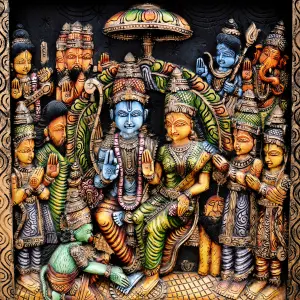How to Read Kundli?
If you are looking to learn how to read a Kundli, which is a Vedic astrology chart that maps out the position of the planets and stars at the time of a person’s birth, there are a few basic elements you need to understand.
The Kundli chart consists of 12 houses, nine planets, and 27 nakshatras, which all play a significant role in determining an individual’s personality traits, strengths, weaknesses, and life events.
The Ascendant or Lagna is an important element of the Kundli chart as it represents the individual’s personality and physical body. Once you understand these basic elements, you can start analyzing the planetary positions and their effects on various aspects of life, such as career, relationships, and health.
Another important aspect of Kundli reading is the Dasha and Antardasha system, which helps in understanding the timing of major life events.
Learning how to read a Kundli requires technical knowledge, intuition, and common sense. It’s important to approach it with an open mind and a willingness to learn. With practice and guidance, anyone can learn to read and interpret a Kundli.

What is Kundli, and What Information does it Provide?
Let’s begin with the basics! Kundli chart, also known as a horoscope or birth chart, is a visual representation of the positions of the planets at the time of a person’s birth. It’s like a snapshot of the universe at the moment of your birth. The information provided by the Kundli includes the positions of the nine planets, 12 houses, and 27 nakshatras (constellations) at the time of birth.
Knowing how to read Kundli is essential to understand the information it provides. Your Vedic Kundli can reveal much about your personality, strengths, weaknesses, career prospects, health, relationships, and more. It’s like a cheat sheet for life! So, if you ever feel lost or need clarification about your purpose in life, learn how to read your Kundli, and it’ll guide you in the right direction.
Different Elements of a Kundli
Get ready to learn how to read Kundli as we explore the intricate details of the 12 houses, 9 planets, and 27 nakshatras that comprise this captivating system.
12 Houses in Kundli
First up, let us talk about the 12 houses. Think of them as different rooms in the cosmic mansion that is your life.
- The first house (AKA the Ascendant) is where you put your best foot forward and show the world your shining personality.
- The second house is where you stash your cash and show off your material possessions.
- The third house is all about communication and socializing with your squad.
- The fourth house is your cosy sanctuary of home and family.
- The fifth house is where you unleash your creative flair and romantic escapades.
- The sixth house is where you roll up your sleeves and get down to business, whether your day job or side hustle.
- The seventh house is all about partnerships and relationships, both romantic and platonic. It’s where you find your ride-or-die and share the highs and lows of life.
- The eighth house is where things get intense. It’s all about shared resources, intimacy, and transformation. Think of joint bank accounts and soulmate connections.
- The ninth house is where you broaden your horizons and seek new adventures. It’s the house of higher learning, travel, and philosophy. Expand your mind, baby!
- In the tenth house, you climb the ladder of success and make your mark on the world. It’s all about your career and public image. You’re a boss, so act like it.
- The eleventh house is your squad goals come to life. It’s where you connect with like-minded individuals and work towards a common goal. Think teamwork, community, and social activism.
- The twelfth house is where you retreat from the world and connect with your inner self. It’s the house of spirituality, dreams, and the unconscious mind. Take a deep breath and let go of all your worries.
9 Planets in Kundli
Moving on to the nine planets, these celestial bodies greatly impact different areas of your life.
- The Sun is like the ultimate spotlight, shining on your talents and strengths.
- The Moon rules your emotions and moods, making you wax and wane like the tides.
- Mars is the fiery planet of action and ambition, propelling you forward with energy and drive.
- Mercury is the quick witted messenger of the gods, helping you communicate and learn new things.
- Jupiter is the lucky planet of expansion and growth, bringing abundance and blessings.
- Venus is the love goddess of beauty and pleasure, guiding you toward all things romantic and artistic.
- Saturn is the wise old teacher who makes you work hard and learn tough lessons.
- The mysterious shadow planets of Rahu and Ketu represent your karmic destiny and spiritual evolution.
27 Nakshatras in a Kundli
Last but not least, we have the 27 nakshatras, AKA the lunar mansions. These cosmic neighborhoods have unique vibes and energy, influencing different aspects of your life.
- Ashwini nakshatra is all about healing and medicine.
- Bharani nakshatra is associated with fertility and birth.
- Krittika nakshatra is fierce and warrior-like.
- Rohini nakshatra is nurturing and fertile.
- Mrigashira nakshatra is curious and playful.
- Ardra nakshatra is intense and transformative. You get the idea!
- Punarvasu nakshatra is all about renewal and second chances. It’s a time to forgive, forget, and move forward.
- Pushya nakshatra is nurturing and maternal, like a warm hug from your mom. It’s all about emotional security and unconditional love.
- Ashlesha nakshatra is sneaky and secretive, like a snake in the grass. Beware of hidden agendas and trust your instincts.
- Magha nakshatra is regal and grand, like the lion king of the jungle. It’s a time to take charge and lead with courage and confidence.
- Purva Phalguni nakshatra is all about romance and luxury. Think champagne, roses, and red velvet curtains.
- Uttara Phalguni nakshatra is refined and elegant, like a ballroom dance. It’s a time to be poised, polished, and diplomatic.
- Hasta nakshatra is skilled and crafty, like a master artisan. It’s time to use your hands and brain to create something beautiful.
- Hasta nakshatra is skilled and crafty, like a master artisan. It’s time to use your hands and brain to create something beautiful.
- Chitra nakshatra is artistic and creative, like a painter with a blank canvas. Let your imagination run wild and express yourself freely.
- Swati nakshatra is balanced and harmonious, like a peaceful breeze on a sunny day. It’s a time to find inner peace and external balance.
- Vishakha nakshatra is ambitious and driven, like a marathon runner. Set your goals high and work hard to achieve them.
- Anuradha nakshatra is loyal and devoted, like a dog to its owner. It’s a time to strengthen your bonds and commit to your loved ones.
- Jyeshtha nakshatra is powerful and authoritative, like a CEO of a company. Take charge and make bold decisions.
- Mula nakshatra is transformative and intense, like a caterpillar turning into a butterfly. Embrace change and let go of what no longer serves you.
- Purva Ashadha nakshatra is adventurous and daring, like a skydiver jumping from a plane. Take risks and live life to the fullest.
So there you have it, a brief overview of the magical world of Kundli chart analysis. Whether you are a seasoned astrologer or just dipping your toes in the cosmic waters, there is always more to discover and explore.
Interpretation of the Ascendant (Lagna) and Its Significance in the Kundli
If you’re wondering how to read Kundli, the Ascendant (Lagna) is the most important point in the Houses as it represents the self and how you interact with the world. It’s the first house and sets the tone for the rest of the Janamkundli. The Ascendant is determined by the zodiac sign rising on the eastern horizon at birth.
To read Kundli, you can also consider the placement of the ruling planet of the Ascendant and any planets in the first house as they can reveal a lot about your personality and physical appearance. So, understanding the effects of some of the other ruling planets of the Ascendant in the Kundli chart can be helpful.
- Sun: If the Sun is the ruling planet of your Ascendant, you may have a strong sense of identity, confidence, and leadership qualities. You may also have a regal or charismatic presence.
- Moon: If the Moon is the ruling planet of your Ascendant, you may have a strong emotional nature, intuition, and nurturing tendencies. You may also tend to have moodiness or emotional sensitivity.
- Mars: If Mars is the ruling planet of your Ascendant, you may have much energy, drive, and passion. You may also tend to impulsiveness or aggression.
- Mercury: If Mercury is the ruling planet of your Ascendant, you may have strong communication skills, intelligence, and wit. You may also tend to restlessness or nervousness.
- Jupiter: If Jupiter is the ruling planet of your Ascendant, you may have a generous and optimistic nature with a strong sense of ethics and spirituality. You may also tend to overindulge or excess.
- Saturn: If Saturn is the ruling planet of your Ascendant, you may have a serious and disciplined nature with an immense understanding of responsibility and duty. You may also tend towards pessimism or self-doubt.
- Rahu/Ketu: If Rahu or Ketu is the ruling planet of your Ascendant, you may have a karmic or spiritual mission in life with a tendency towards seeking enlightenment or higher knowledge. You may also tend to confusion or illusion.
Analysis of the Planetary Positions and their Effects on an Individual’s Life.
Learning how to read Kundli is essential in understanding the positions of the planets in the Vedic astrology chart, which can reveal a lot about a person’s life, including their strengths, weaknesses, career prospects, health, and relationships. By understanding the relationship between the planets, one can gain insight into how they impact the individual’s life. Let us explore some of these planetary patterns and their effects to deepen our understanding of how to read Kundli.
- Mars and Saturn: When Mars and Saturn are in challenging positions, it can indicate a tough time with authority and discipline. You might feel like you are constantly butting heads with your boss or other authority figures. But fear not, my fiery friend! You can overcome these challenges and emerge even stronger with patience and determination.
- Venus and Jupiter: When Venus and Jupiter are in harmony, it is a cosmic lovefest! You might experience a surge of creativity and romance or have great luck in your career or finances. Enjoy this cosmic alignment and spread the love wherever you go!
- Sun and Moon: When the Sun and Moon align, it can signify a time of personal growth and transformation. You might feel more confident, self-assured, and clear about your life path. Embrace this powerful energy and let it guide you toward your dreams.
- Mercury and Uranus: When Mercury and Uranus team up, watch out for lightning bolts of genius! This alignment can bring sudden insights and breakthroughs, especially in technology and communication. Just remember to ground yourself and stay centred amidst the cosmic chaos.
- Neptune and Pluto: When Neptune and Pluto align, it is a time of deep spiritual transformation. You might experience profound insights and revelations about the nature of reality or feel drawn to mystical practices and esoteric knowledge. But be careful not to get lost in the nebulous mists of the unknown – stay grounded and use your newfound wisdom to uplift yourself and others.
Remember that you can shape your destiny no matter which planetary patterns appear in your Kundli chart. Use the energy of the cosmos to your advantage and let your inner light shine bright!
The Importance of the Dasha and Antardasha System in understanding a Kundli
If you’re interested in learning how to read Kundli, understanding the Dasha and Antardasha system can be a great start. This system is commonly used in Vedic horoscope reading to predict important events in a person’s life. It’s based on the Moon’s position at the time of birth and its movement through the 27 nakshatras.
As an individual goes through different planetary periods (Dasha) and sub-periods (Antardasha) throughout their life, these periods can have a significant impact on their life events. To gain a deeper understanding of this system, let’s explore the Dasha and Antardasha of each planet.
- Sun Dasha and Antardasha: You may experience personal growth and achievement during the Sun Dasha. It is a time to shine and showcase your talents. However, during the Sun Antardasha, be mindful of your ego and avoid becoming too self-centred.
- Moon Dasha and Antardasha: The Moon Dasha is a time of emotional sensitivity, intuition, and nurturing. You may feel a strong connection to your family and community. During the Moon Antardasha, focus on self-care and nurturing your own needs.
- Mars Dasha and Antardasha: The Mars Dasha can be a time of high energy, passion, and motivation. You may feel driven to pursue your goals and assert your independence. However, during the Mars Antardasha, be mindful of your temper and avoid impulsive actions.
- Mercury Dasha and Antardasha: The Mercury Dasha is a time of communication, learning, and intellectual growth. You may experience success in areas such as writing, teaching, or public speaking. During the Mercury Antardasha, focus on staying organized and avoiding communication breakdowns.
- Jupiter Dasha and Antardasha: The Jupiter Dasha is a time of growth, expansion, and good fortune. You may experience success in areas such as education, travel, or spiritual growth. During the Jupiter Antardasha, focus on cultivating generosity and avoiding overindulgence.
- Venus Dasha and Antardasha: The Venus Dasha is a time of love, beauty, and creativity. You may experience success in areas such as art, fashion, or romance. During the Venus Antardasha, focus on building healthy relationships and avoiding overspending.
- Saturn Dasha and Antardasha: The Saturn Dasha can be a time of challenges, hard work, and learning essential life lessons. You may experience setbacks or delays but stay focused and disciplined. During the Saturn Antardasha, focus on staying patient and avoiding negative self-talk.
- Rahu Dasha and Antardasha: The Rahu Dasha can be a time of unpredictability, sudden changes, and spiritual growth. You may experience success in areas such as technology, innovation, or unconventional pursuits. During the Rahu Antardasha, focus on staying grounded and avoiding excessive risk-taking.
- Ketu Dasha and Antardasha: The Ketu Dasha is a time of spiritual detachment, introspection, and self-discovery. You may experience success in areas such as meditation, yoga, or alternative healing. During the Ketu Antardasha, focus on letting go of attachments and avoiding isolation.
The Dasha and Antardasha system is important because it helps us understand the timing of major life events and allows us to prepare for them. By knowing which Dasha and Antardasha you are currently in, you can make the most of the opportunities and challenges that come your way.

Understanding the Position of the Moon in the Kundli and Its Impact on an Individual’s Emotions and Mind
The Moon in the Kundli Horoscope analysis represents our emotions, instincts, and how we react to different situations. Its placement in a particular birth chart reading and house can significantly impact an individual’s emotional and mental well-being.
- For example, Suppose the Moon is in a Fire sign such as Aries, Leo, or Sagittarius. In that case, the individual may have a strong sense of self and be passionate and enthusiastic. However, they may also tend to impulsivity and anger.
- On the other hand, if the Moon is in an Earth sign such as Taurus or Virgo Or Capricorn, the individual may be more grounded and practical in their emotional responses. They may deeply appreciate the finer things in life and value stability and security. However, they may also need help with being too materialistic or stubborn.
- The individual may be intellectual and social if the Moon is in an Air sign such as Gemini, Libra, or Aquarius. They are likely to have a quick wit and a charming personality, making them popular in social circles. However, they may also struggle with emotional detachment and indecisiveness, like a wind-blown leaf.
- On the other hand, if the Moon is in a Water sign such as Cancer, Scorpio, or Pisces, the individual may be deeply intuitive and empathetic. They will likely have a rich inner world and be in tune with their emotions, like a fish swimming in a vast ocean. However, they may also be prone to moodiness and emotional volatility, like the ebb and flow of the tides.
The Moon also forms aspects with other planets, which can further influence its impact on the individual’s emotions and mind. Here is a brief explanation of the Moon’s effect on an individual’s emotional and mental well-being based on its placement in each planet’s Dasha and Antardasha.
- Moon in Sun Dasha and Antardasha: During this period, the individual’s emotions and instincts may be influenced by their ego and sense of self. They may feel the need to assert themselves and struggle with balancing their own needs with the needs of others.
- Moon in Moon Dasha and Antardasha: This period can be emotionally intense as the individual may be more in tune with their feelings and experience heightened sensitivity. They may have strong intuition and rely on their gut instincts to make decisions.
- Moon in Mars Dasha and Antardasha: This period can be challenging as the individual may feel more impulsive, angry, or aggressive. They may struggle to control their emotions and be prone to conflicts or arguments.
- Moon in Mercury Dasha and Antardasha: During this period, the individual’s emotions may be influenced by their communication and thinking style. They may be more analytical and use logic to make decisions rather than relying on their feelings.
- Moon in Jupiter Dasha and Antardasha: This period can be a time of emotional growth and expansion. The individual may feel optimistic and generous and have a greater sense of purpose in life.
- Moon in Venus Dasha and Antardasha: This period can be a time of emotional connection and creativity. The individual may feel more romantic and artistic and strongly desire harmony and beauty.
- Moon in Saturn Dasha and Antardasha: This period can be emotionally challenging as the individual may experience sadness, loneliness, or depression. They may also feel more responsible and struggle to balance their emotions and sense of duty.
- Moon in Rahu Dasha and Antardasha: During this period, individuals’ desires and obsessions may influence their emotions. They may feel more intense emotions and may struggle with controlling their impulses.
- Moon in Ketu Dasha and Antardasha: This period can be a time of spiritual growth and detachment. Individuals may feel less attached to their emotions and focus more on their inner world and spiritual practices.
By understanding the position of the Moon in your Kundli reading, you can gain insights into your emotional nature and learn how to work with it to live a more fulfilling life.
Well, there you have it, folks! Reading a Kundli chart may seem daunting, but with a little knowledge and practice, you’ll be able to decode the cosmic blueprint of your life like a pro. Just remember, a Kundli chart is like a roadmap that can guide you on your journey, but ultimately, it’s up to you to decide which path to take. So go ahead, explore the stars, and may your cosmic adventures be filled with laughter, love, and plenty of planetary alignments in your favour! Now that you have learnt how to read kundli, use this knowledge to read kundli for career and read kundli for marriage.





